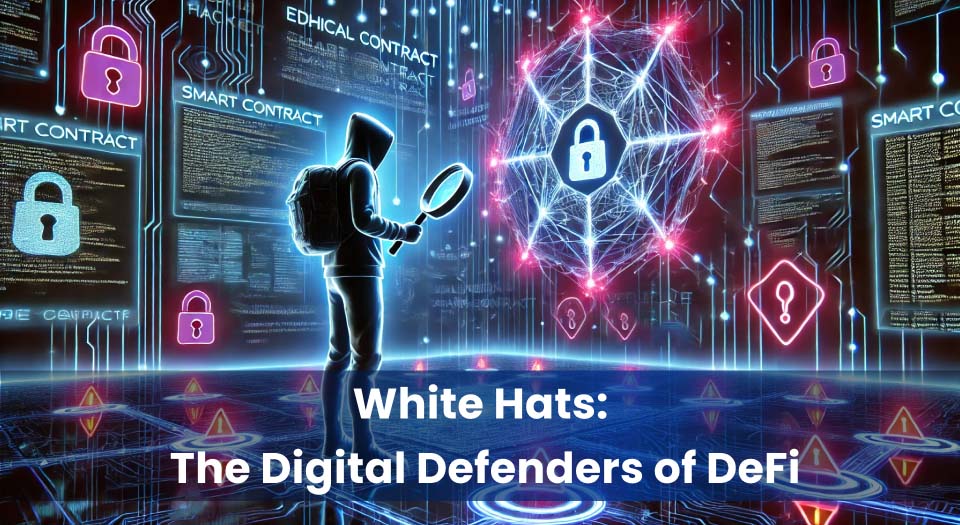




DeFi threats in 2025 are becoming more sophisticated, targeted, and difficult to detect. As decentralised finance (DeFi) platforms continue to expand their reach and total value locked (TVL), they have become prime targets for increasingly advanced cyberattacks—ranging from flash loan exploits and oracle manipulation to cross-chain vulnerabilities and governance abuse.
Despite improved auditing tools and smart contract standards, DeFi remains uniquely vulnerable due to its public, permissionless, and composable nature. In response to this dynamic threat landscape, ethical hackers—also known as white hat security researchers—are playing a critical role in identifying and mitigating risks before malicious actors can exploit them.
In this article, we explore the most pressing DeFi threats in 2025, the innovative methods ethical hackers use to expose and neutralise vulnerabilities, and how platforms can proactively strengthen their defences in a trustless ecosystem.
The threat landscape for decentralised finance platforms has evolved rapidly. In 2025, attackers are leveraging composability, anonymity, and permissionless access to bypass traditional controls. Many DeFi protocols still lack effective detection or containment strategies—especially in cross-chain environments.
Below are the most pressing DeFi threats in 2025, categorised by type and severity:
| Threat Type | Description | Impact |
|---|---|---|
| Flash Loan Attacks | Zero-collateral loans used to manipulate prices or votes within a single transaction. | High – Up to USD 50M lost in recent cases |
| Oracle Manipulation | Altering price feeds to trigger arbitrage or liquidation events. | Critical – Often undetected until exploited |
| Governance Exploits | Acquiring voting power to push malicious proposals. | Moderate to High – DAO takeovers possible |
| Bridge Vulnerabilities | Exploiting flaws in cross-chain asset transfer protocols. | High – Often systemic across ecosystems |
| Wallet Drainers | Phishing campaigns that request approvals to drain funds. | High – Scalable and often irreversible |
While these threats may appear technical, the underlying issue is often a lack of proactive defence design. Many DeFi protocols prioritise innovation over security, assuming open-source contributions and community feedback will be enough. Unfortunately, in 2025’s threat environment, reactive strategies are insufficient.
For instance, recent flash loan exploits have leveraged not just protocol-level vulnerabilities, but also flaws in governance mechanisms and incentive models. Ethical hackers now focus not only on code-level issues, but also on economic design flaws that invite manipulation.
For ongoing analysis of DeFi attack trends, resource like Rekt News provide live data and post-mortems of major exploits.

In response to rising DeFi threats in 2025, a growing community of ethical hackers is actively working to expose and fix vulnerabilities before malicious actors exploit them. These professionals—commonly known as white hats—perform independent assessments, simulate attacks, and submit responsible disclosures through coordinated programs.
Unlike traditional security audits, which often rely on pre-launch code reviews, ethical hackers adopt an offensive mindset. They think like adversaries, probing smart contracts, oracle mechanisms, governance systems, and token economics for weaknesses. Their goal is not to criticise code, but to prevent catastrophic losses by catching issues early.
Platforms such as Immunefi and Hats Finance provide structured bounty programs, offering significant rewards (often exceeding USD 1 million) to hackers who find and report high-impact bugs. In fact, in 2024 alone, over USD 90 million in bounties were paid out via Immunefi—demonstrating the scale and seriousness of ethical hacking in Web3.
Ethical hackers also run private forks of mainnet environments to test exploit feasibility, combine on-chain and off-chain data to simulate multi-step attacks, and collaborate across communities to identify systemic risks.
Theory alone isn’t enough to justify the value of ethical hacking. Several high-profile cases in recent years highlight how white hat hackers have directly prevented massive losses in the DeFi ecosystem—often acting faster than internal teams or audits.
In 2023, a white hat identified a reentrancy vulnerability in a new Curve Finance pool before it went live. If exploited, the bug could have led to a liquidity drain of over USD 40 million. The vulnerability was responsibly disclosed through Immunefi, patched within 48 hours, and the researcher was rewarded USD 1.5 million—the largest DeFi bounty at that time.
In 2023, a white hat identified a reentrancy vulnerability in a new Curve Finance pool before it went live. If exploited, the bug could have led to a liquidity drain of over USD 40 million. The vulnerability was responsibly disclosed through Immunefi, patched within 48 hours, and the researcher was rewarded USD 1.5 million—the largest DeFi bounty at that time.
Hats Finance has also played a key role in coordinating proactive disclosures for emerging DeFi projects—often identifying critical logic flaws in token issuance, vesting schedules, and oracle inputs before going public.
The exponential growth of DeFi has been matched by an equally rapid evolution in cyber threats. From flash loan attacks and governance exploits to cross-chain manipulation and phishing-based wallet drainers, the risks facing decentralised platforms in 2025 are as complex as the protocols themselves.
But there is hope. Ethical hackers—armed with deep technical expertise, adversarial thinking, and responsible disclosure platforms—are working behind the scenes to protect Web3 users. Their role in identifying critical bugs, coordinating with protocols, and preventing catastrophic losses has become indispensable.
To defend against DeFi threats in 2025, proactive security must go beyond audits. It must involve realistic attack simulations, protocol-specific penetration testing, and working with the best white hats in the space.
🔐 Want to test your DeFi protocol like a hacker would?
Fort1 offers advanced penetration testing for Web3 projects—tailored to smart contracts, tokenomics, governance, and bridge security.
✅ Contact us at Fort1 to schedule your DeFi security assessment today and stay one step ahead of the threats shaping 2025.

Fort1 provides comprehensive cybersecurity solutions tailored to protect your business from evolving digital threats. With expertise in penetration testing, dark web monitoring, and managed detection services, we empower organisations to stay secure and resilient in the face of modern cyber challenges.
Copyright @2024 Fort1. All Rights Reserved by Fort1.